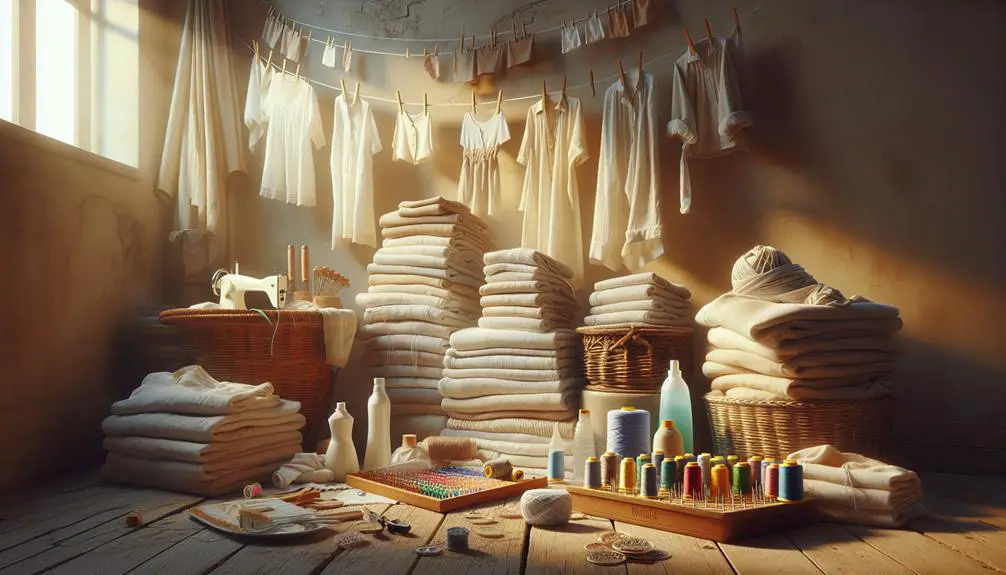When it comes to extending the lifespan of your fabrics, attention to detail can make all the difference. You'll want to start by washing your clothes with care, choosing the delicate cycle and cold water. But that's just the beginning. Have you ever wondered how the type of detergent you use or the way you dry your clothes impacts their durability? There's a lot more you can do to guarantee your favorite garments stay in top condition. Let's explore the specific steps you can take to keep your fabrics looking fresh and new for as much time as possible.
Table of Contents
Key Takeaways
- Use the delicate cycle and cold water to reduce wear and prevent color fading.
- Choose gentle, properly measured detergents to avoid residue buildup and fabric degradation.
- Air dry fabrics to prevent shrinkage and fiber weakening from high heat.
- Store fabrics in breathable containers to ensure airflow and prevent mold.
- Rotate your wardrobe to prevent excessive wear and extend the lifespan of garments.
Wash With Care
Proper washing techniques can greatly extend your fabric's lifespan. To start, always consider using the delicate cycle on your washing machine. This setting is designed to be gentler on your clothes, reducing the wear and tear that more aggressive cycles can cause.
Pair this with cold water, which not only helps to prevent color fading but also minimizes fabric shrinkage and fiber damage.
Once your fabrics are clean, resist the urge to toss them into a hot dryer. Instead, opt for air drying. This method is much gentler and helps to preserve the integrity of the fabric.
If you need to remove wrinkles, iron lightly at the appropriate temperature. Overheating can weaken fibers and diminish the fabric's overall quality.
Use Proper Detergents
To extend the life of your fabrics, always opt for gentle detergent formulas. Harsh chemicals can break down fibers, so it's best to avoid them.
Make sure you measure the detergent properly to prevent residue buildup that can weaken the material.
Choose Gentle Formulas
Choosing a gentle detergent can greatly prolong the life of your fabrics. Not all detergents are created equal; some contain harsh chemicals that can break down fibers over time. Opting for milder formulations helps maintain the integrity and color of your clothes, so they look newer for longer.
When considering fabric softeners, harmful or helpful, it's pivotal to weigh their benefits against potential drawbacks. Traditional fabric softeners can leave residues that attract dirt and weaken fabric strength. Instead, look for eco-friendly detergent options that incorporate natural softening agents. These options effectively clean without compromising the longevity of your fabrics, and they're better for the environment too.
You should also avoid detergents with strong fragrances and dyes, as these can irritate sensitive skin and degrade fabric quality. Many eco-friendly detergent options are free from these additives, making them a smart choice for both you and your clothes.
Avoid Harsh Chemicals
Avoiding harsh chemicals is just as important as choosing the right detergent to keep your fabrics in top condition. When you use harsh chemicals, you risk breaking down the fibers, causing wear and tear much faster.
Opt for fabric-friendly cleaning methods that rely on eco-friendly alternatives. Natural solutions like vinegar or baking soda can be surprisingly effective and gentle on your fabrics.
You don't need to compromise on cleanliness to avoid harsh chemicals. There are numerous gentle methods that can achieve the same, if not better, results. Look for detergents specifically formulated to be gentle on fabrics. These options are often free from phosphates, bleaches, and synthetic fragrances that can be damaging.
Switching to eco-friendly alternatives not only preserves the integrity of your fabrics but also contributes to a healthier environment. Using plant-based detergents or soaps can be a game-changer. They're designed to clean without stripping away the natural fibers.
Measure Detergent Properly
Accurately measuring your detergent is crucial for maintaining the integrity and longevity of your fabrics. Using the right amount guarantees proper fabric care and maximizes detergent effectiveness. Too much detergent can lead to residue build-up, which attracts dirt and can degrade fabric fibers. Too little, and your clothes won't get clean enough, reducing their lifespan.
To master detergent measurement, always follow the instructions on the detergent packaging. Use a measuring cup for liquid detergents and a scoop for powders. Remember, different detergents have varied concentrations, so don't presume one size fits all.
Let's break down the basics:
| Detergent Type | Recommended Measurement |
|---|---|
| High-Efficiency (HE) Liquid | 2 tablespoons per load |
| Standard Liquid | 1/4 cup per load |
| HE Powder | 2 tablespoons per load |
| Standard Powder | 1/4 cup per load |
| Detergent Pods | 1 pod per load |
Avoid Overloading the Washer
Packing the washer too tightly can lead to less effective cleaning and increased wear on your fabrics. When you overload your washer, clothes don't have the space they need to move freely and get thoroughly cleaned. This not only leaves detergent residue but also causes friction among garments, accelerating fabric deterioration.
For best results, practice good washer maintenance and fabric organization. Start by properly sorting your laundry. Separate heavy items like jeans and towels from lightweight fabrics. This not only ensures well-balanced loads but also prevents damage to more delicate items.
Use delicate cycles for fragile fabrics, as these cycles are gentler and minimize wear and tear. It's important to leave enough space in the drum for clothes to agitate freely. A good rule of thumb is to fill the washer about two-thirds full. This allows water and detergent to circulate effectively, leading to cleaner clothes and reduced strain on fabrics.
Dry Fabrics Correctly
Proper drying techniques are crucial for maintaining the quality and longevity of your fabrics. To safeguard your garments last for years, follow these best practices:
- Air Dry Whenever Possible: Air drying is the gentlest method for your fabrics. Hang clothes on a line or drying rack to lessen wear and tear from the dryer.
- Use the Gentle Cycle: When you must use a dryer, opt for the gentle cycle. This setting uses lower heat and slower tumbling, which minimizes fabric stress and prevents shrinkage.
- Avoid Overloading the Dryer: Just like with your washer, overloading the dryer can cause friction and damage. Give your clothes enough room to tumble freely, guaranteeing even drying and reducing wrinkles.
- Remove Clothes Promptly: As soon as the drying cycle is complete, take your fabrics out immediately. This prevents wrinkles from setting in and reduces the need for ironing, which can further harm delicate fibers.
Store Fabrics Properly
To store fabrics properly, keep them out of direct sunlight to prevent fading and deterioration.
Use breathable containers to avoid trapping moisture, which can lead to mold and mildew.
These simple steps will help preserve the quality and longevity of your fabrics.
Avoid Direct Sunlight
Direct sunlight can cause fabrics to fade and deteriorate quickly, so storing them away from windows and bright areas is crucial. When fabrics are exposed to UV rays, their fibers break down, leading to significant fabric fading and reduced fabric longevity. To maintain your textiles' vibrant colors and strength, follow these practical tips for sun protection.
- Use Curtains or Blinds: Install curtains or blinds in rooms where you store fabrics. This simple step can significantly reduce UV exposure and help preserve your fabric's quality.
- Store in Dark, Cool Places: Choose storage spaces that are naturally dark and cool. Basements, closets, or drawers can be excellent options to safeguard your fabrics from sunlight.
- Rotate Fabric Positions: If you can't avoid some exposure to light, rotate the positions of your stored fabrics periodically. This will make sure that no single piece is continuously exposed to sunlight, minimizing the risk of uneven fading.
- Cover with Protective Cloths: Drape a protective cloth over your fabrics to act as an additional barrier against UV rays. Using materials like muslin or cotton can offer effective sun protection without compromising breathability.
Use Breathable Containers
While protecting fabrics from sunlight is essential, storing them in breathable containers guarantees they stay fresh and free from mold and mildew.
One of the key aspects of fabric preservation is ensuring proper airflow. Breathable containers, such as cotton storage bags or acid-free boxes, offer an ideal environment for your fabrics. They allow air to circulate, which helps in moisture control, preventing the buildup of dampness that can lead to mold and mildew.
Consider these storage tips: avoid plastic containers, as they trap moisture and create a breeding ground for bacteria. Instead, opt for breathable fabric bags or boxes.
Before storing, make sure your fabrics are clean and completely dry. Any residual moisture can cause significant damage over time.
Additionally, place your fabrics in a cool, dry area away from direct sunlight. Attics and basements mightn't be the best choices due to fluctuating temperatures and humidity levels. Instead, choose a closet or under-bed storage where conditions remain stable.
Handle Stains Promptly
Addressing stains as soon as they occur can greatly extend the life of your fabrics. Quick action is essential for effective stain removal and overall fabric care. Here's how you can master the art of handling stains promptly:
- Spot Treatment: Immediately blot the stain with a clean cloth or paper towel. Avoid rubbing, as it can push the stain deeper into the fabric fibers. Use a gentle, fabric-specific cleaner for spot treatment.
- Cold Water Rinse: Rinse the stained area with cold water as soon as possible. Cold water helps to prevent the stain from setting in. For protein-based stains like blood or sweat, cold water is particularly beneficial.
- Pre-Treat Stubborn Stains: Apply a pre-treatment solution to stubborn stains before washing. Let it sit for a few minutes to break down the stain molecules. This step enhances the effectiveness of the washing process.
- Regular Inspection: Make it a habit to inspect your garments for stains regularly. Addressing minor stains promptly prevents them from becoming permanent and maintains the overall quality of your fabrics.
Mastering these techniques won't only keep your fabrics looking pristine but also extend their lifespan, ensuring your wardrobe remains in top condition.
Rotate Your Wardrobe
Regularly changing up your wardrobe can prevent excessive wear on your favorite pieces and guarantee all your garments get equal use. By incorporating seasonal styles, you'll not only keep your closet fresh but also make sure that each item gets its time to shine. Break your wardrobe into capsule collections that you can switch out every few months. This approach helps you focus on a smaller set of clothes, making it easier to maintain and care for each piece.
Color coordination is another effective strategy. Group your clothes by color and rotate them regularly. This method allows you to create new and exciting outfit combinations, keeping your look dynamic. Plus, it makes outfit planning more straightforward, saving you time in the morning.
Outfit planning itself can be a game-changer. Spend a few minutes each week planning your outfits to make certain you're making the most of your wardrobe. Rotate through different pieces to avoid overusing any single item. This not only extends the life of your fabrics but also keeps you looking stylish and polished.
Frequently Asked Questions
How Can I Prevent Fabric Color Fading Over Time?
To master fabric color protection, wash your clothes in cold water, avoid direct sunlight when drying, and use color-safe detergents. These steps are key to preventing color fading and keeping your fabrics vibrant longer.
What Are the Best Practices for Ironing Different Types of Fabrics?
To master ironing techniques, adjust heat settings for each fabric type. Use proper ironing tools like a steam iron and pressing cloth for delicate fabrics. Pay attention to fabric care labels to avoid damaging your garments.
How Do I Maintain the Softness of My Fabrics?
Maintaining the softness of your fabrics is like nurturing a delicate plant. Use fabric softener alternatives like vinegar, and apply natural fabric care techniques such as air drying and gentle washing to guarantee long-lasting, luxurious textures.
Are There Specific Tips for Extending the Life of Delicate Fabrics?
To extend the life of delicate fabrics, use proper storage tips and fabric care. Opt for gentle washing techniques and avoid harsh detergents. Maintain fabric longevity by air-drying and storing them in cool, dry places away from sunlight.
What Are the Benefits of Air-Drying Versus Machine Drying for Fabrics?
Air drying benefits include energy saving and reduced fabric wear. Machine drying risks fabric damage and shrinkage. You'll protect your clothes and the environment by choosing air drying over the potentially harsh effects of machine drying.
- How Does Ring Spun Cotton Affect Garment Fit and Shape Retention? - August 13, 2024
- What Are the Challenges in Producing Ring Spun Cotton? - August 13, 2024
- Is Ring Spun Cotton Suitable for Plus-Size Clothing? - August 13, 2024





